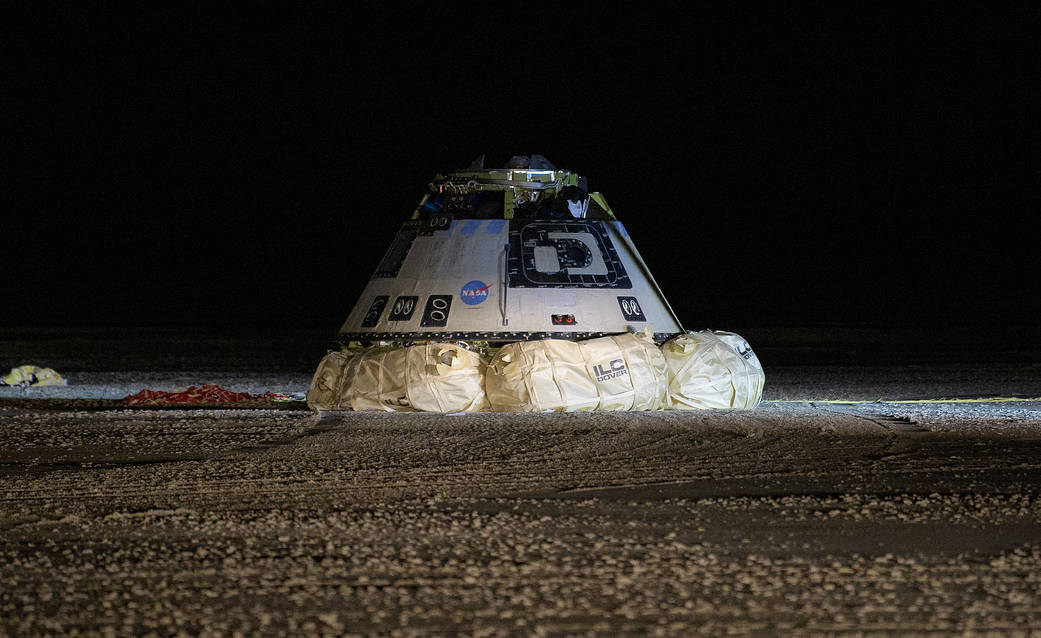Boeing CEO Muilenburg Resigns 1 Day After Starliner's Historic Landing

The next time Boeing's Starliner crew capsule flies, it will be under different company leadership.
Boeing announced the resignation of CEO Dennis Muilenburg today (Dec. 23), one day after Starliner capped its truncated debut flight with a picture-perfect landing at White Sands Missile Range in New Mexico.
Muilenburg is stepping down effective immediately, Boeing representatives said. Boeing chief financial officer Greg Smith will serve as interim CEO before Muilenburg's permanent replacement, current board chairman David Calhoun, takes the reins on Jan. 13.
Related: Boeing's 1st Starliner Flight Test in Photos
The leadership change likely has little if anything to do with Starliner, the spacecraft that Boeing is developing to fly NASA astronauts to and from the International Space Station (ISS). Rather, it's widely seen as a response to the problems Boeing has experienced with its new 737 Max airplane, which crashed twice during a five-month span recently, claiming more than 300 lives.
"A change in leadership was necessary to restore confidence in the company moving forward as it works to repair relationships with regulators, customers and all other stakeholders," Boeing representatives said in a statement today.
Starliner launched Friday (Dec. 20) on its first-ever spaceflight, an uncrewed mission to the ISS called Orbital Flight Test (OFT). But the capsule suffered a glitch with its internal timing system shortly after liftoff and didn't make it up to the orbiting lab.
Breaking space news, the latest updates on rocket launches, skywatching events and more!
Starliner ended up spending 48 hours in orbit rather than the originally planned eight days, coming back down to Earth on Sunday morning. But the capsule notched some important milestones during the brief flight. Launch and landing, the two most important phases of flight from an astronaut-safety standpoint, went well, and Starliner performed well in the space environment, NASA and Boeing representatives said.
OFT was supposed to clear the way for a crewed test flight next year. It's unclear at the moment if that's still the plan, or if Starliner will need to demonstrate an ISS docking before astronauts fly on the capsule. That decision will be made after all the OFT data is analyzed, NASA and Boeing representatives said.
Like Boeing, SpaceX holds a NASA contract to fly astronauts to and from the orbiting lab. The California-based company will fulfill this deal using its Crew Dragon capsule, which aced its version of OFT, a six-day, uncrewed jaunt to the ISS and back called Demo-1, in March.
Crew Dragon is scheduled to demonstrate its emergency-escape system in flight next month. If that goes well, a crewed test flight to the ISS will follow.
- Boeing's CST-100 Starliner Space Capsule (Infographic)
- Boeing in Space: The Latest News, Images and Video
- How Boeing's Starliner Orbital Flight Test Works: A Step-By-Step Guide
Mike Wall's book about the search for alien life, "Out There" (Grand Central Publishing, 2018; illustrated by Karl Tate), is out now. Follow him on Twitter @michaeldwall. Follow us on Twitter @Spacedotcom or Facebook.


Michael Wall is a Senior Space Writer with Space.com and joined the team in 2010. He primarily covers exoplanets, spaceflight and military space, but has been known to dabble in the space art beat. His book about the search for alien life, "Out There," was published on Nov. 13, 2018. Before becoming a science writer, Michael worked as a herpetologist and wildlife biologist. He has a Ph.D. in evolutionary biology from the University of Sydney, Australia, a bachelor's degree from the University of Arizona, and a graduate certificate in science writing from the University of California, Santa Cruz. To find out what his latest project is, you can follow Michael on Twitter.
